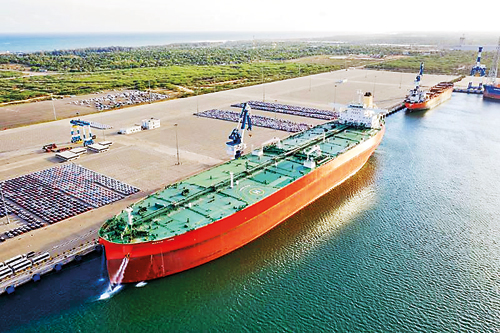Accelerating legal cooperation along the Belt and Road for ‘Green Recovery’

China is involved in many projects in Sri Lanka like the Hambantota port for instance
The Belt and Road Initiative (BRI) is poised to play a green, inclusive and transformative role in the post-COVID-19 global recovery process in line with the UN 2030 Agenda for Sustainable Development. To this end, the Green Development Guidance for BRI Projects Baseline Study Report has been released on 01.12.2020 by the Belt and Road International Green Development Coalition (BRIGC) of the Ministry of Ecology and Environment of China. By following international best practices, this report has taken a commendable initiative towards developing a set of clear and operable guidelines to help all stakeholders join forces in accelerating green, low-carbon, and sustainable investments in BRI projects.
As the BRI continues to develop, the need for legal cooperation arises to meet the demand for ‘soft infrastructure’, namely the institutions that help maintain legal, regulatory and financial systems, information technology services, etc. Soft infrastructure is a vital element for strengthening the BRI’s hard infrastructure, namely physical connectivity via conducive transportation networks.

Mr. Dilum Abeysekera
In this context, “legal cooperation along the Belt and Road” means and includes cross-border collaboration in law enforcement through consistent legal, regulatory and administrative procedures and practices. Effective legal cooperation necessitates harmonization of different legal provisions or systems by eliminating major differences and creating minimum requirements or standards leading to legal certainty, consistency and predictability.
Promoting legal cooperation is the path to laying a stable legal foundation for the BRI towards realizing the shared vision of all participating countries. A stable legal foundation provides the enabling legal support and safeguards for the BRI to operate efficiently across borders.
The need to develop a stable legal foundation for the BRI is articulated in the statement of Co-Chairs of the Forum on Belt and Road Legal Cooperation jointly held by the Ministry of Foreign Affairs of China and China Law Society in July 2018. This statement recommends “all parties participating in the BRI develop multi-level, multi-channel and comprehensive legal cooperation by exploring the establishment of cooperation mechanisms, identifying priorities through consultation, making action plans progressively, solving legal issues effectively and building consensus constantly, in order to lay a solid legal foundation for the BRI”. As a way forward, the statement suggests that further discussions under the theme of the BRI legal cooperation be conducted in appropriate forums in the future.
Legal cooperation to catalyze innovation, entrepreneurship and inclusive growth in BRI countries
According to the UN 2030 Agenda for Sustainable Development, “International trade is an engine for inclusive economic growth and poverty reduction, and contributes to the promotion of sustainable development”.
Sustainable Development Goal 9 is focused on building resilient infrastructure, promoting inclusive and sustainable industrialization and fostering innovation.
Legislative reforms are inevitable where legal frameworks are not in place or not sufficient to give effect to the 2030 Agenda.
Efficient laws and regulations help advance innovation, entrepreneurship and inclusive economic growth while reducing poverty and inequality. A number of authorities including the World Bank’s “Doing Business” data support that there is a strong association between inequality, poverty and business regulation. Doing Business – 2017 reported that economies with poor quality business regulation have higher levels of income inequality on average. As reported in Doing Business – 2018, economies with better business regulation have lower levels of poverty on average.
The “Ease of Doing Business” (EODB) is an index developed by the World Bank’s Doing Business annual report team to rank 190 economies on their ease of doing business from rank 1 to 190. The EODB indicates an economy’s position to the best regulatory practice in relation to 10 themes – the best score is set at 100, and the lowest performance is set at 0.
The EODB score can be reasonably used as an effective indicator for measuring the “BRI-readiness” of national regulatory frameworks of participating countries. BRI countries can increase their EODB scores by reducing differences in regulatory performance starting with, for instance, the indicators associated with “Trading across Borders”.
China has achieved exemplary progress in the Doing Business rank among 190 economies by improving it to 31st place in 2019 from 46th in 2018 and 96th in 2013.
Promotion of legal cooperation along the Belt and Road is an excellent opportunity for participating countries to undertake review, revision and reform of their legal, regulatory and policy frameworks towards boosting innovation, entrepreneurship and inclusive economic growth.
BRI as a major accelerator of United Nations Sustainable Development Goals (UN SDGs)
A careful examination of the five priority areas of the BRI and the UN SDGs reveals their complementary, mutually reinforcing and synergistic relationship. The 193 Member States of the UN have made a commitment to ensure the implementation of the 2030 Agenda for Sustainable Development by means of a revitalised Global Partnership. In that sense, the BRI clearly stands out as an essential constituent partner of the Global Partnership for Sustainable Development that strengthens the means of SDG implementation as set forth in Goal 17.
As stated by the UN Secretary General Antonio Guterres at the opening ceremony of the Belt and Road Forum for International Cooperation in Beijing, China on April 26, 2019: “The five pillars of the Belt and Road – policy coordination, facilities connectivity, unimpeded trade, financial integration, and people-to-people exchanges – are intrinsically linked to the 17 Sustainable Development Goals” .
It is worthy to quote the UN Secretary General’s remarks once again, made at the opening of the Belt & Road Forum in Beijing, China on 14.05.2016: “While the Belt and Road Initiative and the 2030 Agenda are different in their nature and scope, both have sustainable development as the overarching objective. Both strive to create opportunities, global public goods and win-win cooperation. And both aim to deepen “connectivity” across countries and regions; connectivity in infrastructure, trade, finance, policies and, perhaps most important of all, among peoples. In order for the participating countries along the Belt and Road to fully benefit from the potential of enhanced connectivity, it is crucial to strengthen the links between the Initiative and the Sustainable Development Goals. Those 17 Goals can guide the policies and actions under the Belt and Road towards true sustainable development”.
Legal cooperation to help
harness the BRI’s green
development dividends
A green BRI can provide a platform for all participating countries to contribute to realizing inclusive, transformative and green recovery in the post-Covid-19 context.
The Green Development Guidance for BRI Projects Baseline Study Report – 2020 is based on international best practices drawn from governments, financial institutions and non-governmental organisations (NGOs) on their environmental policies, safeguard measures and actions for greening investments. Government institutions of BRI countries at both national and local levels can help realize green recovery by integrating these guidelines with their regulatory systems.
This Baseline study Report has put forward a BRI project classification system that forms the positive and negative lists, and proposed recommendations to guide green development of the BRI projects. The classification of BRI projects investigates three major environmental objectives: pollution prevention, climate change mitigation, and biodiversity conservation.
BRI projects are divided into three categories based on
positive and negative impacts:
1. Red projects requiring stricter supervision and regulation: These are projects at risk of causing “significant and irreversible” environmental damage or major negative environmental impacts in one or more aspect(s) of climate change mitigation, pollution prevention, and biodiversity protection. Red projects include coal-fired power, hydropower, petrochemical, and mining and metal smelting projects.
2. Yellow projects – environmentally neutral with moderate impacts: Projects in this category “Do No Significant Harm” (DNSH) to any environmental aspect, and any residual environmental harm can be mitigated by the project itself through affordable and effective measures within reasonable boundaries. Yellow projects include waste-to-energy projects and urban freight transportation with emission standard above Euro IV/national IV standards (or similar locally applicable standards).
3. Green projects – encouraged: Projects in this “encouraged category” have no significant negative impact on any environmental aspect of climate change mitigation, pollution prevention, and biodiversity protection, and positively contribute to at least one environmental aspect, particularly if they support international environmental agreements and conventions. Projects such as renewable energy development and utilization (solar and wind power plants, etc.) fall into this category.
Way forward
Some suggestions for BRI
participating countries:
1. Make a collaborative effort with all participating countries to build and benefit from the BRI as a major Global Partnership for Sustainable Development towards realizing the United Nations 2030 Agenda including the SDGs.
2. Incorporate the recommendations of the Green Development Guidance for BRI Projects Baseline Study Report – 2020 with national and local environmental regulatory frameworks.
3. Accelerate action on legal cooperation among BRI countries aimed at improving the efficiency and effectiveness of national and local regulatory frameworks.
4. Take action to secure higher scores (over 80% for instance) of the “Ease of Doing Business” (EODB) index developed by the World Bank. Eliminate or minimize differences in regulatory performance among BRI countries, for instance, the differences in “Trading across Borders”.
5. Partner with the Belt and Road International Green Development Coalition (BRIGC) of the Foreign Environmental Cooperation Office, Ministry of Ecology and Environment of China, and act towards jointly building a green, inclusive and sustainable BRI.
6. Join the United Cities and Local Governments – Asia Pacific Committee on Belt and Road Local Cooperation (BRLC) which is an ideal platform for local government institutions to promote the Green BRI by addressing issues relating to legal cooperation, among others.



